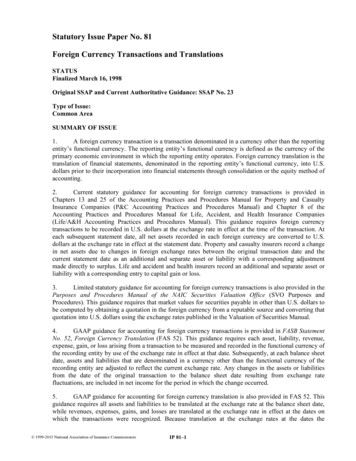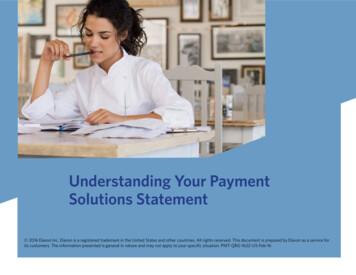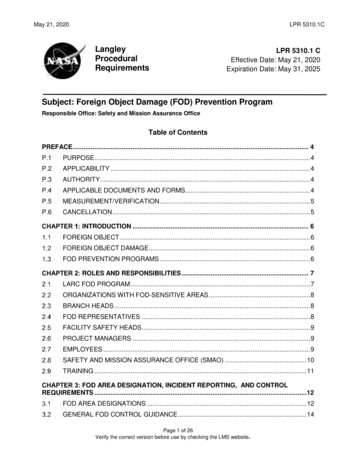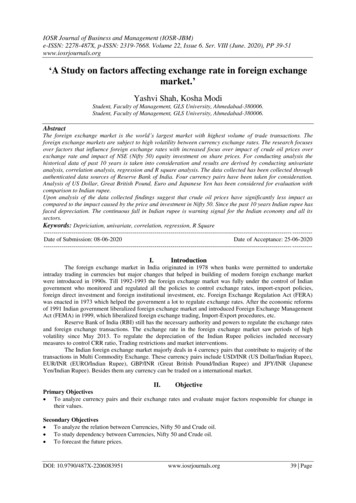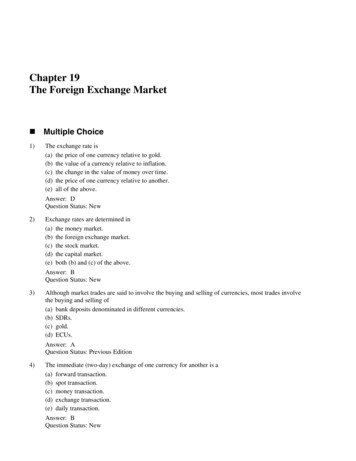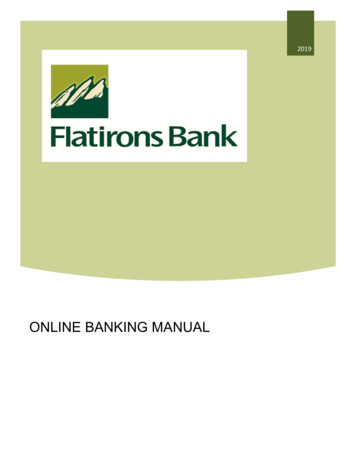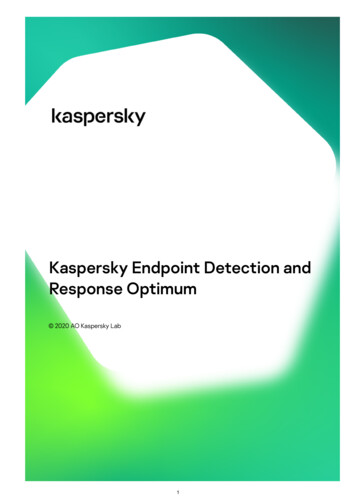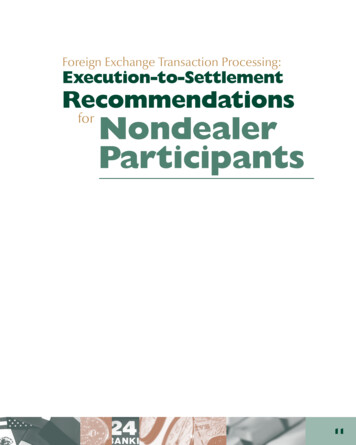
Transcription
Foreign Exchange Transaction orNondealerParticipants11
Table of ContentsIntroduction .13The Foreign Exchange Market .13The Changing Marketplace .13What Is the Foreign Exchange Committeeand What Are the Best Practices? .14How to Use This Document .14Pre-Trade Preparationand Documentation .15Process Description .15Recommendation No. 1: Determine ForeignExchange Needs and DevelopAppropriate Infrastructure .15Recommendation No. 2: EnsureSegregation of Duties.16Recommendation No. 3: DetermineAppropriate Documentation.16Trade Execution and Capture .18Process Description.18Recommendation No. 4: EstablishAppropriate Trading Policiesand Procedures .18Recommendation No. 5: Clearly IdentifyCounterparties.19Recommendation No. 6: Establishand Control System Access.20Recommendation No. 7: Enter Tradesin a Timely Manner.20Confirmation .21Process Description.21Recommendation No. 8: Confirm Tradesin a Timely Manner.21Recommendation No. 9: Block TradesShould Be Confirmed in a Timely Manner .22Recommendation No. 10: ResolveConfirmation Discrepanciesin a Timely Manner .22Recommendation No. 11: Unique Featuresof Foreign Exchange Options .23Recommendation No. 12: Unique Featuresof Non-deliverable Forwards .2412Netting and Settlement .25Process Description .25Recommendation No. 13: Net Paymentsand Confirm Bilateral Amounts .25Recommendation No. 14: Provide Accurateand Complete Settlement Instructions.26Recommendation No. 15: Use StandingSettlement Instructions.27Recommendation No. 16: Understand RisksAssociated with Third-Party Payments .27Account Reconciliation.28Process Description .28Recommendation No. 17: Perform TimelyAccount Reconciliation.28Recommendation No. 18: IdentifyNonreceipt of Payments and SubmitCompensation Claims in a Timely Manner.29Accounting and Control.29Process Description .29Recommendation No. 19: Conduct DailyGeneral Ledger, Position, and P&LReconciliation.30Recommendation No. 20: Conduct DailyPosition Valuation.30Other .31Recommendation No. 21: Develop and TestContingency Plans .31Recommendation No. 22: Ensure ServiceOutsourcing Conforms to Best Practices.31Acknowledgments .33Recommended Readings .34FOREIGN EXCHANGE COMMITTEE 2004 ANNUAL REPORT
Foreign Exchange Transaction orNondealerParticipantsIntroductionThe Foreign Exchange MarketThe foreign exchange (FX) market is the largest and most liquid sector of the globalfinancial system. According to the Bank for International Settlements’ TriennialCentral Bank Survey of Foreign Exchange and Derivatives Market Activity 2004, FXturnover averages USD 1.9 trillion per day in the cash exchange market and an additional USD 1.2 trillion per day in the over-the-counter (OTC) FX and interest ratederivatives market.1 The FX market serves as the primary mechanism for makingpayments across borders, transferring funds, and determining exchange ratesbetween different national currencies.The Changing MarketplaceOver the past decade, the FX market has grown in terms of both volume and diversityof participants and products. Although commercial banks have historically dominated the market, today’s participants also include investment banks, brokeragecompanies, multinational corporations, money managers, commodity trading advisors,insurance companies, governments, central banks, and pension and hedge funds.In addition, the size of the FX market has grown as the economy has continued toglobalize. The value of transactions that are settled globally each day has risenexponentially—from USD 1 billion in 1974 to USD 1.9 trillion in 2004.13
What Is the Foreign ExchangeCommittee and What Are the BestPractices?The Foreign Exchange Committee is an industrygroup sponsored by the Federal Reserve Bankof New York that has been providing guidance and leadership to the global FX marketsince its founding in 1978. In all its work, theCommittee seeks to improve the efficienciesof the FX market, to encourage steps toreduce settlement risk, and to supportactions that enhance the legal certainty of FXcontracts.In 1998, the Committee recognized theneed for a checklist of best practices thatcould help nondealer participants enteringthe FX market to develop internal guidelinesand procedures for managing risk. Theoriginal version of Foreign ExchangeTransaction Processing: Execution-to-SettlementRecommendations for Nondealer Participantswas published in 1999 by the Committee’sOperations Managers Working Group toserve as a resource for market participants asthey evaluate their policies and proceduresregarding FX transactions. This 2004 updatetakes into account market practices that haveevolved since the paper’s original publicationand supersedes previous recommendationsby the Committee regarding nondealerparticipants.The purpose of this paper is to share theexperiences of financial institutions that areactive in the growing FX market with nondealer participants that may participate in the114FX market on a more occasional basis. Thetwenty-two issues highlighted are meant topromote risk awareness and provide “bestpractice” recommendations for nondealers.Participants in prime brokerage or similararrangements should also be familiar withthese recommendations. The implementationof these practices may mitigate some of thetrading and operational risks that are specific tothe FX industry. It may also help limit potentialfinancial losses and reduce operational costs.This document is primarily oriented towardnondealer participants with moderate FXactivities. However, those nondealer participants that are particularly active in the FXmarket are encouraged to review theCommittee’s guidance to other marketparticipants, specifically the Guidelines forForeign Exchange Trading Activities and theManagement of Operational Risk in ForeignExchange. These documents provide a moredetailed discussion of the business practicesand operational guidelines appropriate toinstitutions with larger or more complex FXactivities. Copies of these papers areavailable on the Committee’s website at www.newyorkfed.org/fxc .How to Use This DocumentThis document is divided into sections basedon the five steps of the FX trade process flow:1) pre-trade preparation, 2) trade executionand capture, 3) confirmation, 4) netting andsettlement, and 5) account reconciliation andaccounting/financial control processes. HowBank for International Settlements, Triennial Central Bank Survey of Foreign Exchange and Derivatives Market Activity 2004 (Basel: Bank forInternational Settlements, 2004).FOREIGN EXCHANGE COMMITTEE 2004 ANNUAL REPORT
Figure 1The Foreign Exchange Process FlowAccounting and Financial ControlPre-TradePreparationTrade Executionand CaptureConfirmationNetting andSettlementAccountReconciliationProblem Identification, Investigation, and ResolutionManagementManagement and Exception Reportseach of these individual phases integrateswith the others in the FX process flow is outlined in Figure 1 above. Each section of thispaper provides a process description, followed by a list of best practices specific to thatphase. The paper concludes with general bestpractices that apply to overall risk management, including guidance for contingencyplanning and service outsourcing.procedures and practices for ensuring thesafe and sound conduct of business.Pre-Trade Preparationand DocumentationBefore initiating activities in the FX market,a company should perform a thoroughassessment of its FX needs within the contextof its business and financial strategy. The risksassociated with engaging in FX activities—including market, liquidity, credit, legal,operational, and settlement risk—need to beidentified, quantified, and managed. Clearpolicies and procedures governing all aspectsof FX trading and processing should beestablished, documented, and maintained.Because the nature of a firm’s participation inthe FX market may continually change andProcess DescriptionThe pre-trade preparation and documentation process initiates the business relationshipbetween two parties. During this process,both parties’ needs and business practicesshould be established. An understanding ofeach counterparty’s trading characteristicsand level of technical sophistication shouldalso develop. In summary, the pre-tradeprocess allows the two parties to agree uponRecommendation No. 1:Determine Foreign Exchange Needsand Develop AppropriateInfrastructureIt is critical for each firm to determine its underlyingFX requirements and establish the appropriateinfrastructure to support its activities.FOREIGN EXCHANGE TRANSACTION PROCESSING15
evolve, policies and procedures should beperiodically reviewed and updated.All market participants should ensure thatthey engage sufficient experienced personnelto execute the firm’s FX mandate. Each groupor individual playing a role in the FX processflow should have a complete understandingof how FX trades are initiated, recorded,confirmed, settled, and accounted for.Insufficient knowledge of the overall FXprocess, or the role played by each individualor group, can lead to an improper segregationof duties, inadequate controls, and increasedrisk. All market participants should provideongoing employee education regardingbusiness strategies, roles, responsibilities, andpolicies and procedures.A clear policy on ethics should beestablished, such as a code of conduct thatconforms to applicable laws, good convention,and corporate policies. In particular, theguidelines should address the issue of thereceipt of entertainment and gifts on the partof trading staff and others in a position toinfluence the firm’s choice of counterparties.Senior management should ensure that thepolicies are well circulated, understood, andperiodically reviewed by all personnel. Suchpolicies should be updated regularly toensure they cover new business initiatives andmarket developments.responsibilities. Reporting lines for trading andoperational personnel should be independent,and management should ensure that appropriatesegregation of duties exists between operationsand other business lines and within operations.Responsibility for trade execution, tradeconfirmation, payments, and general ledgerreconciliation should be segregated to thegreatest extent possible. At a minimum,responsibility for trade execution should besegregated from responsibility for subsequentprocessing steps. When such duties are notsegregated, the potential for fraud mightincrease. An individual may be able tocomplete unauthorized trades and hide anyresultant losses.Individuals responsible for confirmation,settlement, and reconciliation must be able toreport any and all issues to managementindependent of the trading function. To do so,operations staff must have a reporting line thatis not subject to an organizational hierarchythat could lead to a compromise of control.Firms with small treasury staffs and an overlapin employee responsibilities should establishand document workflows and systems toprevent unauthorized activities. Such arrangements should be periodically verified by anindependent audit function.Recommendation No. 3:Recommendation No. 2:Ensure Segregation of DutiesNondealer participants should preclude individualsfrom having concurrent trading, confirmation,payment, and general ledger reconciliation16Determine AppropriateDocumentationAn institution should determine its documentationrequirements and know whether those requirements have been met prior to trading.FOREIGN EXCHANGE COMMITTEE 2004 ANNUAL REPORT
An institution should begin FX tradingactivities only if it has the proper documentation in place. The use of industry standarddocuments is strongly encouraged to provide asound mutual basis for conducting financialmarket transactions. A variety of documentsensure the smooth functioning of the marketsand protect participants in these markets: Authority documents address capacity—the right of an institution to enter into atransaction—and authority—permissionfor an individual to act on the institution’sbehalf. Confirmations summarize the significanttrade terms and conditions agreed uponby the parties. Master agreements contain terms thatapply to broad classes of transactions,expressions of market practice andconvention, and terms for netting, termination, and liquidation.2 Standard settlement instructions providefor the exchange of payment instructionsin a standardized, secure, and authenticated format.Each institution is responsible for ensuringthat it has the capacity to enter into a transaction, as well as to monitor and enforcecompliance with its internal proceduresregarding any limitations there may be on the23trading authority of its employees or thirdparties acting on its behalf. Thus, providing todealing firms documentation that includes anumber of investment limitations and restrictions affecting a participant’s ability to trade andinvest is not consistent with best marketpractice.3Before executing a master agreement with acounterparty, an institution should alsoestablish a policy on whether or not it willtrade and in what circumstances. It should alsobe noted that electronic trading often requiresadditional or different documentation.Specifically, customer and user identificationprocedures, as well as security procedures,should be documented.Nondealer participants should be aware thatdealers are likely to be subject to statutory,regulatory, and supervisory requirements for“knowing” their customers. Dealers need toknow the identity of their counterparties, theactivities they intend to undertake with thedealer, and why they are undertaking thoseactivities. While each dealer may havedifferent procedures for implementing theserequirements, nondealer participants shouldcooperate in providing the information thatallows dealers to fulfill these obligations.The Financial Markets Lawyers Group (FMLG), an industry organization of lawyers representing major financial institutions sponsored bythe Federal Reserve Bank of New York, has helped draft documentation for FX activities, including the International Foreign ExchangeMaster Agreement, the International Foreign Exchange and Options Master Agreement, the International Currency Options MarketMaster Agreement, and the International Foreign Exchange and Currency Options Master Agreement. These documents, endorsed bythe Committee, are available on the FMLG’s and the Committee’s websites, www.newyorkfed.org/fmlg and www.newyorkfed.org/fxc , respectively.For related guidance on this issue, see the letter to market participants on the Committee’s website.FOREIGN EXCHANGE TRANSACTION PROCESSING17
Trade Executionand Capturecarefully reconfirm key terms with thecounterparty before ending the call.Process DescriptionThe trade execution and capture function isthe second phase of the FX processing flow.Deals may be transacted directly over arecorded phone line or through Internetbased systems (for example, proprietary tradingsystems or multidealer trading platforms).Trade information captured typically includestrade date, time of execution, settlementdate, counterparty, financial instrument traded,amount transacted, price or rate, and mayalso include settlement instructions.Firms should ensure that all trading isconducted at current market rates. Tradesexecuted at off-market rates can conceallosses, facilitate accounting misstatements, ormask other illegitimate activities. Off-markettrades also involve the extension of creditfrom one party to the other. Nondealerparticipants should establish controls todetect off-market dealing, such as comparingactual trade rates against daily market rangesand reviewing position revaluation results forunreasonable gains or losses.Establish Appropriate TradingPolicies and ProceduresFirms should endeavor to execute transactions in amanner that reduces the possibility of misunderstandings, errors, or unauthorized dealing. Oncecompleted, FX trades constitute binding obligationsfor both parties. Although subsequent processingsteps (for example, confirmation) may uncoverproblems, the best protection from unanticipatedloss is to avoid problems from the outset.In certain cases, valid business purposesmay exist for completing off-market trades.Firms intending to complete off-market trades,including historical rate rollovers, shouldprovide counterparties such additionalinformation as is necessary to establish anunderlying business purpose, as well asevidence that such dealing has been reportedto and approved by senior management.4Responsibilities regarding monitoring andreporting off-market transactions should beclearly defined.Transactions should be executed only byinternally authorized staff who are fullyconversant with market practice andterminology. Firms should avoid the use ofobscure market jargon that may lead toconfusion or miscommunication. Whentrades are verbally executed, traders shouldFirms electing to leave orders with FXdealers should establish a clear mutualunderstanding of how such orders will behandled, particularly with respect to fast ordiscontinuous markets or more seriousmarket disruptions. Firms should clearly agreeon the specific terms of the order, particularlyRecommendation No. 4:418The Committee’s letter on historical rate rollovers, first published in December 1991, continues to offer sound advice to those who needto execute these transactions. The letter, reprinted in the Committee’s 1995 Annual Report, is available on the Committee’s website, www.newyorkfed.org/fxc .FOREIGN EXCHANGE COMMITTEE 2004 ANNUAL REPORT
when such orders are activated, canceled, ormodified by the occurrence of subsequentevents. If certain aspects of an order arecontingent upon the achievement of specificmarket levels, firms should agree in advanceupon the rate or price sources to be used insuch determination.Given the twenty-four-hour nature of theFX market, nondealer participants shouldhave a clear policy on dealing off thepremises or during off-hours. Firms allowingsuch activity should consider institutingprocedures to ensure that trades executedduring off-hours are promptly reported toothers in a prearranged manner (for example,e-mail, voicemail). the organization has been involved inacquisition, divestiture, or restructuringactivity that has led to name changes; and participants are transacting in an agencycapacity.Identification failure raises a number ofpotential risks, including: incorrect assessment of counterparty performance risk; erroneous bookings and/or misdirectedsettlements, creating potential losses foreither counterparty to the transaction; misallocation of collateral; or disclosure of transaction information toincorrect entities.Recommendation No. 5:Clearly Identify CounterpartiesAll participants should clearly identify the legalentity on whose behalf they are undertaking atransaction. Trading on an unnamed basis iscontrary to best market practice.Each counterparty to a transaction shouldensure that its organization recognizes theimportance of clearly and accurately identifyingthe legal entities involved in the transaction.Additionally, firms should encourage staff toprovide their names and affiliation in allcounterparty communication. The benefits ofclear counterparty identification are particularlyevident when: the organization has multiple legal entities(subsidiaries, branches, offices, and affiliates) that are trading in the FX market;The practice of trading FX on an unnamedbasis—also referred to as undisclosed principaltrading—presents an adverse risk to bothindividual market participants and thebroader financial market. Such practicesconstrain a dealer’s ability to assess thecreditworthiness of its counterparties and tocomply with “know your customer” and antimoney-laundering rules and regulations—exposing dealers to clear and significant legal,compliance, credit, and reputational risks aswell as heightening the risk of fraud. It isrecommended that investment advisors anddealers alike implement measures toeliminate the practice of trading on anunnamed basis. Specifically, investmentadvisors and FX intermediaries should developa process to disclose client names to a dealer’scredit, legal, and compliance functions beforethe execution of FX trades.FOREIGN EXCHANGE TRANSACTION PROCESSING19
Recommendation No. 6:Establish and Control System AccessAs alternative technologies continue to emerge inthe FX trading and processing environments,rigorous controls need to be implemented andmonitored to ensure that data integrity and securityare not undermined. Each system should haveaccess controls that allow only authorized individuals to alter the system and/or gain user access.The use of electronic interfaces among FXmarket participants—such as electroniccommunications networks (ECNs) andautomated trading systems (ATSs)—hasincreased significantly in recent years. Useof robust electronic interfaces is encouragedas it reduces trading- and operations-relatederrors, particularly when trade data flowdirectly from the electronic trading platformto the front-end trading system and to theoperations system books and records in orderto achieve straight-through processing.To maximize the benefits of thesedevelopments, access to production systemsshould be allowed only for those individualswho require such access to perform their jobfunction. Lack of adequate access controlsand related monitoring can result inunauthorized trading activity. Without properaccess control, the flow of data between theelectronic trading platform and the tradingsystems or back-office books and records canbe altered, compromising data integrity andsubjecting the firm to the risk of financial loss.their access revoked. Under no circumstanceshould operations or trading functions havethe ability to modify a production system ifthey are not authorized.Recommendation No. 7:Enter Trades in a Timely MannerAll trades should be entered immediately intoappropriate systems and be accessible for bothtrading and operations processing as soon asthey are executed.It is crucial that all trades are entered immediately so that all systems and processes havetimely, updated information. Front-end systemsthat capture deal information may interfacewith other systems that monitor and updatecredit limit usage, intraday profit and loss (P&L),trader positions, confirmation status, settlement instructions, and general ledger activity.An institution’s ability to manage risk may beadversely affected if it does not have accuratetransaction updates in each of the abovementioned areas. The failure to recordtrades promptly misrepresents contractualpositions and can result in: inaccurate accounting records, mismanagement of market risk, misdirected or failed settlement, and the failure of a trade to be booked at all.System access and entitlements should beperiodically reviewed, and users who nolonger require access to a system should have20FOREIGN EXCHANGE COMMITTEE 2004 ANNUAL REPORT
ConfirmationProcess DescriptionThe transaction confirmation is evidence ofthe terms of an FX or a currency derivativetransaction. Therefore, proper management ofthe confirmation process is an essential control.This process is handled in many ways within FXmarkets. For spot, forward FX, or vanilla currency option transactions, counterpartiesexchange electronic or paper confirmationsthat identify transaction details and provideother relevant information. For structured andnonstandard transactions (for example, nondeliverable forwards [NDFs] and exotic currency option transactions), documents areprepared and 1) exchanged and matched byboth counterparties, in the case of most dealers,or 2) signed and returned in the case of certaincounterparties.5All confirmations should be subject eitherto the 1998 FX and Currency Option Definitionsissued by the Committee, EMTA, and the International Swaps and Derivatives Association(ISDA) or to other appropriate guidelines.Recommendation No. 8:Confirm Trades in a Timely MannerBoth parties should make every effort to sendconfirmations or positively affirm trades withintwo hours after execution and in no event laterthan the end of the day.Prompt confirmations are key to theorderly functioning of the marketplacebecause they reduce market risk andminimize losses due to settlement errors. In5the absence of timely confirmation, tradediscrepancies may go undetected, which canlead to disputes, disrupting the settlementprocess and increasing processing costs. Suchdiscrepancies can also result in failed tradesor inaccurate accounting records and canadversely affect any underlying securitysettlement. The incidence of error tends toincrease when non-automated or verbalconfirmations are not followed up withwritten or electronic confirmation. Given thesignificance of the confirmation process, it isimportant that the process is handledindependently of the trading function.Counterparties should have an understanding regarding confirmation practices,that is, whether they will both send out theirown confirmations, or whether one counterparty will sign and return (affirm) incomingconfirmations. It is not recommended thateither party simply accept receipt of thecounterparty confirmation as completion ofthe confirmation process.Confirmations should be transmitted in asecure manner whenever possible. In themost developed markets, confirmations aregenerally sent via electronic message througha secure network. Automated confirmationmatches one party’s trade details to itscounterparty’s trade details. It minimizesmanual error and is the most timely andefficient method because it requires nosubsequent confirmation or manual check.While a significant number of transactionconfirmations are also sent via mail, e-mail, orTypically, the price maker prepares the confirmation and the price taker signs the confirmation.FOREIGN EXCHANGE TRANSACTION PROCESSING21
fax, it is important to note that when theseopen communication methods are usedthere is a greater risk of human error orfraudulent correspondence. When sendingconfirmations by fax or e-mail, or whenconfirming by telephone, counterparties mayagree to take additional steps to ensure receiptby the correct counterparty. Telephoneconfirmations should be used when no othermethod is available. Following the telephoneconfirmation, both parties should exchangeand match written or electronic confirmations.With verbal confirmations, most dealersemploy recorded telephone lines. Nondealer participants may want to consideradopting this practice.Data included in the confirmation shouldcontain the following: the counterparty to theFX transaction, the office through which it isacting, the transaction date (or trade date),the value date (or settlement date), the amountsof the currencies being bought and sold, thebuying and selling parties, and settlementinstructions. Amended confirmations shouldbe sent promptly when necessary. Settlement instructions for forward transactionsshould be reconfirmed two days before thesettlement date.Once a trade between counterparties hasbeen confirmed, such trades may be thesubject of novation or other similar agreements,which should be confirmed in a similarlyvigorous manner.Recommendation No. 9:Block Trades Should Be Confirmed ina Timely MannerThe full amount of block trades transacted byagents should be confirmed as soon as possible,but always within two hours of the trade execution.Investment managers or others acting as anagent may undertake “block” or “bundled”trades on behalf of multiple counterparties.Such trades are subsequently split into smalleramounts and apportioned to specific underlying funds or counterparties. The failure toallocate a block trade on a timely basis couldresult in increased credit, legal, and operationalrisk. Specifically, a delay in allocation hampersthe allocation and management of creditexposure. Trade confirmation will also bedelayed, which in turn may interrupt thesettlement process and, in extreme cases, causepayment failures.The full amount of block trades should beconfirmed as soon as possible but always withintwo hours of trade execution. Allocations andconfirmations to individual obligor accountsshould be completed within four hours andno later than the end of the day on the tradedate. To minimize errors caused by manualintervention, trade allocations should, ifpossible, be provided to the counterpartyelectronically, either through a securenetwork or through authenticated means.Recommendation No. 10:Resolve Confirmation Discrepanciesin a Timely MannerDiscrepancies between a confirmation receivedfrom a counterparty and a firm’s own recordsshould be brought to the counterparty’s attention22FOREIGN EXCHANGE COMMITTEE 2004 ANNUAL REPORT
immediately. Escalation procedures should beestablished to resolve any unco
The foreign exchange (FX) market is the largest and most liquid sector of the global financial system. According to the Bank for International Settlements' Triennial Central Bank Survey of Foreign Exchange and Derivatives Market Activity 2004, FX turnover averages USD 1.9 trillion per day in the cash exchange market and an addi-


